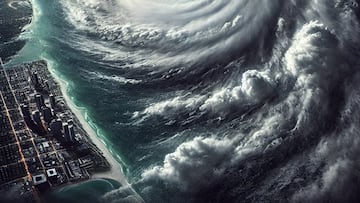What is the difference between hurricane categories 1, 2, 3, 4, 5?
All hurricanes are equal, but some are more equal than others. Find out which ones cause the most damage.

As Hurricane Helene and John hit parts of the United States, it’s worth noting that hurricanes are classified into different categories based on their wind speeds and potential for damage. The Saffir-Simpson Hurricane Wind Scale is commonly used to categorise hurricanes from Category 1 to Category 5, with Category 1 being the least severe and Category 5 the most severe.
Here’s a breakdown of the categories and the damage they can wreak.
How can I identify the hurricane category?
Category 1: 74-95 mph (119-153 km/h)
At their weakest, hurricanes cause some damage to roofs, siding, and trees. Small boats may be damaged or capsized. Storm surge typically 4-5 feet above normal.
Category 2: 96-110 mph (154-177 km/h)
More extensive damage to roofs, trees, and power lines comapred to Category 1. Storm surge typically 6-8 feet above normal.
A system that's forecast to become Hurricane Helene will move into the Gulf, prompting Florida Gov. DeSantis to declare a state of emergency for 41 counties ahead of its expected landfall in the Sunshine State Thursday. @Ginger_Zee tracks it all out. https://t.co/95vaozPH8L pic.twitter.com/p1h7btEDuI
— World News Tonight (@ABCWorldNews) September 24, 2024
Category 3: 111-129 mph (178-208 km/h)
There is significant damage to homes, trees, and power lines. The storm surge will be 9-12 feet above normal with widespread coastal and low-lying area flooding.
Category 4: 130-156 mph (209-251 km/h)
Severe damage to well-built homes alongside the destruction of mobile homes, and significant damage to infrastructure. Storm surge typically 13-18 feet above normal. Severe coastal and low-lying area flooding will happen; the Big Bend is the area of Florida which will receive this type of battering.
Category 5: 157 mph (252 km/h) or higher
Catastrophic damage to buildings, infrastructure, and vegetation. Complete destruction of mobile homes. Storm surge typically greater than 18 feet above normal means severe and widespread coastal flooding.
Remember Hurricane Katrina?🌀
— Leon Simons (is fine) (@LeonSimons8) May 22, 2024
That was 2005.
2024 will be a year to remember! https://t.co/aTuA5mAXFU pic.twitter.com/ule4Y8BAsz
One of the most infamous Category 5 hurricanes was Hurricane Katrina in 2005. It made landfall in Florida in this Category though it continued to cause incredible damage when it his Louisiana at Category 3; the design of the city and its flood defence system contributed to its damage potential.
What potential damage can hurricanes cause?
Related stories
The damage potential of a hurricane is not solely determined by wind speed; factors like storm surge, rainfall, and the region’s vulnerability also play a significant role.
🌊On June 27, 1957, Hurricane Audrey, one of the most intense June Atlantic hurricanes on record, made landfall near the Texas/Louisiana border, killing nearly 400 people and causing $150 million in damage pic.twitter.com/0KEDDT7lZ0
— RetroNewsNow (@RetroNewsNow) June 27, 2024
Higher category hurricanes not only have stronger winds but also bring more rainfall and generate larger storm surges, making them more destructive and dangerous.
Complete your personal details to comment